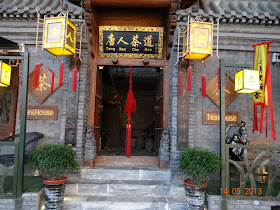After a long day at Yonghehong, a leisurely lunch at Mr. Shi's at Baochao Hutong, a draining walk down the Nanluogouxiang Hutong, an energising walk along Dongbuyaqiao Alley to the Drum and Bell Towers, we headed to Houhai, a place which my parents loved when they visited Beijing and recommended as a must-visit.
While we headed towards, we passed by Yan Dai Xie Jie, which literally means "Slanted Tobacco Pipe Street". The street itself resembles a huge pipe totally 232 meters long. It is "slanted "because it runs from the northeast to southwest.
During the early part of the reign of the Qing Dynasty the street was called "Slanted Drum Tower Street" since it was just located about 100 meters to the south of Drum Tower. Much towards the end of the Qing Dynasty the name of the street was changed to "Slanted Tobacco Pipe Street". At that time there were a great number of shops selling pipes - tobacco pipes were quite popular then, brought in by the Westerners. Today, most of the tobacco shops and pipe shops have gone, but you will find trendy stores, bars and gastronomical delights on offer.
A plaque showing the layout of Yan Dai Xie Jie and the street as it looks today!
Yan Dai Xie Jie is quite a trendy place!
Azucar Bar or "Sugar Bar" - I still remember some Spanish that I started learning last year....
And a boutique displayed this news report on an entrepreneur who made a killing selling T-shirts with the face of Obama, but changing his name to ObaMao!!! We saw these T-shirts earlier at the Great Wall!
When a mojito is f**king good, you just shut up and drink! That's the spirit to live by!
Succulent Peking Duck and other skewered meats!
We finally reached Houhai!
Houhai (后海), which literally means the "Rear Sea" is a lake in the Xicheng District of central Beijing. Houhai, the lake, forms the part of Shichahai - a system of three lakes - Qianhai ("Front Sea") and Xihai ("Western Sea"), being the other two.
The history of the Shichahai system of lakes can be traced to as far back as the Jin Dynasty (1115 - 1234). During the Yuan Dynasty (1271 - 1368), it was the terminal point of the Great Canal, which was a main reason for its prosperity. In the period of the Ming Dynasty (1368 - 1644), when the channels ceased to be as smooth as they used to be, it changed from a bustling hub of trade to a place of leisure where people could stroll around to admire the vast scenery or enjoy the cool shade under willow trees.
Since the early 2000s, the hutong neighborhood around Houhai has become known for its nightlife as many residences along the lake shore have been converted into restaurants, bars, and cafes. The area is especially popular with foreign tourists visiting Beijing and also young locals. Perhaps, the change that Shichahai has seen over the centuries exemplifies how cities and neighbourhoods too evolve like living beings....
People were out here having a good time....

"Silver Ingot"- or "Yinding" bridge (银锭桥) - I wonder why it's called that way....
At Yinding Bridge, we came across Kao Rou Ji - "kao rou" means "grilled meat." "Ji" is the family name of the restaurant's founder. It started as a grilled mutton stall set up by a certain Ji Decai in 1848. Since the Manchu, who controlled Beijing at the time, liked grilled meats, and since Ji was a Muslim, Ji decided to specialize in grilling mutton. Legend says Ji Decai was a favorite of the Qing Dynasty rulers. Time passed, in the 1940s, Ji's descendants bought a traditional Chinese-style building near Ingot Bridge, and the place became famous as Kao Rou Ji.
Weddings are a big business in China - this couple were getting their pre-nup photoshoot done - the photographer gets a wonderful twilight canvas to paint on!
As the sun sets, Houhai comes alive! The hutong starts pulsating with each passing minute!
A seimming competition at Houhai!
This is a common sight - Chinese girls love posing for the camera - they come up with such "professional" poses!

And now to Starbucks for a well deserved cuppa!















































No comments:
Post a Comment